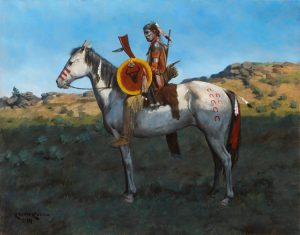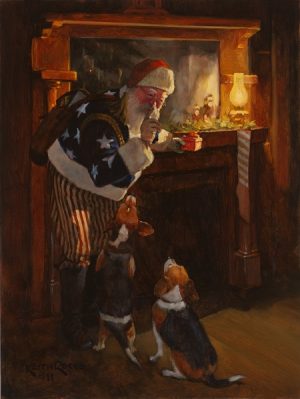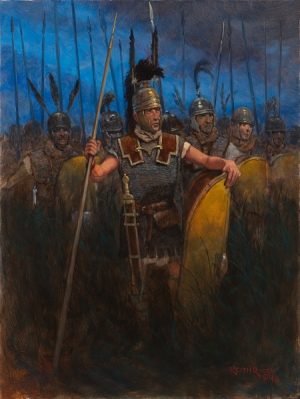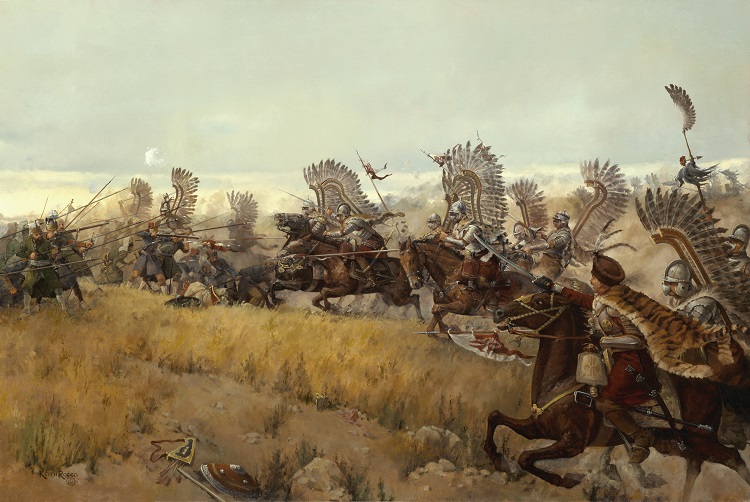The Avenging Angels
Description
200 signed and numbered prints
Battle of Vienna, Sept. 12, 1683
This battle is classified by historians as one of the most decisive battles of the world. The Turkish Empire was then at the peak of its power and occupied most of southeastern Europe. A powerful Turkish army of 110,000 led by Grand Vizier Kara Mustafa laid siege to Vienna in August 1683. The Turks’ seizure of the city would mean the fall of the Austrian Empire, leaving the middle of Europe open to Turkish invasion, and would probably have changed the course of history of Christendom and European civilization.
Part of the Austrian army defended the city. The rest, though bolstered by German troops, were unable to face the Turks on their own, so awaited the coming of the Polish army. Polish relations with Austria and Germans were not very friendly, but the king of Poland, Jan III Sobieski, understood very well that the fall of Vienna would be disastrous for his country and the rest of Europe. In the spring of 1683, a pact of mutual aid against Turkish attack was signed between the Polish King and the Holy Roman Emperor Leopold I of Austria.
The Polish army of 27,000 soldiers, half of which was cavalry including 3,300 hussars, was assembled in the second half of August, and because of the gravity of the situation the King marched south, not waiting for the Lithuanians. Near Vienna, Polish forces were joined by Austrian and German troops, and the allied army totaled about 75,000 soldiers. According to the pact, the Polish King became the commander-in-chief. His military genius and victories over past 20 years were all too well known. During the council of war on Sep 3, the King devised a battle plan for the allied forces.
On Sep 12, the army approached Vienna and took positions against the Turks besieging the city. A small hussaria unit was sent to charge enemy lines to examine the terrain and explore the possibility of an all-out assault. The result was positive, and in spite of the late afternoon start, the King decided to attack with all allied cavalry to prevent the Turks from preparing stronger defenses. Polish hussaria attacked in the center and on the right wing and took the Turkish camp, together with the palace-like tents of Kara Mustafa and an enormous booty. The Austrians and Germans charged on the left and also broke enemy lines. The Turkish army was completely defeated. The war lasted a few more months, but from that day on, the Turkish Empire was on retreat in southeast Europe.
Turkish standards and other trophies were sent to the Pope in Rome and victory was celebrated with solemn masses all over Europe.
In 1690 one of the constellations was named “Scutum Sobieskii” (Sobieski’s Shield) to commemorate the battle.
Armor, Armament and Wings
Hussaria was the cream of the Polish army and mainly, though not exclusively, nobility served in its ranks and files. Once in service, soldiers were paid, but they were responsible for equipping themselves and their squires at considerable cost. The armor was light for speed and protected the arms and upper parts of the body. The armament consisted of 15-foot-long lances (the only equipment provided by the King), sabers, estocs (piercing rapiers), and pistols.
The famous wings were not obligatory; however, many soldiers of hussaria used them. The wings were light wooden frames with rows of feathers and were attached to the back of the armor, sometimes to the saddle. Their purpose was not just decorative. During high-speed charges, the wings produced a buzzing sound which frightened enemy horses and disturbed enemy troops who saw winged horsemen charging at them. Also, the Tartars’ lasso, or “arkan”, was difficult to use against soldiers with wings protruding above their heads. Wings, though not universally used, were the distinctive feature of hussaria and became its symbol. Today, hussaria wings are present in emblems of the Polish Air Force and Armored Divisions.
Hussaria was considered to be heavy assault cavalry only by the Polish and Lithuanian army. The West did not have this type of cavalry, and hussaria was considered light by western standards of speed and tactics. The main task of hussaria during battle was to breach enemy formations. Polish commanders of the 16th and 17th centuries realized that the effectiveness of firearms was still very limited, so a charge by a good horseman had to endure at most one salvo before reaching the enemy with lances and sabers. This was sound reasoning, and hussaria won most battles they fought, in many cases against foes of far greater numbers. This was the case for the span of nearly two centuries.
In the initial phases of a charge, hussaria loosened and tightened their formation a few times in order to diminish the effect of enemy fire. The charge was started at low speed and riders accelerated during its progress, reaching top speed just before the enemy. This not only preserved the horses’ strength, but also had psychological effects on the enemy who saw the preliminaries to the charge. Extremely long but light lances were used to break opponents’ formations, and were supposed to break during the clash. After the lances were gone, sabers and estocs were used.
When the first charge was not successful, hussaria withdrew and charged again. There were battles in which the same troops charged 10 times and later helped pursue the enemy. This was possible only with highly trained units that could withdraw and regroup in an orderly manner.
Except in a few cases, casualties suffered by hussaria were very low, and this was the best proof of their worth, as well as proof of the talent of Polish commanders of the time.
Except from ‘Hussaria – Polish Winged Cavalry
By Slawek K. Grzechnik
Additional information
| Medium | |
|---|---|
| Size | 13" x 20", 20" x 30" |
| Type |
Related products
-

Olivia
$275.00 Add to cart -

Northern Plains Indian – Original
$1,500.00 Select options This product has multiple variants. The options may be chosen on the product page -

Victorian Santa
$70.00 – $100.00 Select options This product has multiple variants. The options may be chosen on the product page -

Triarii-Punic Wars – Original
Read more

